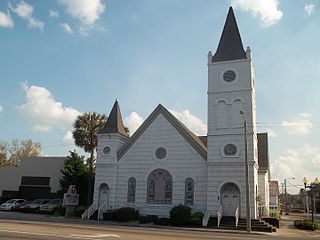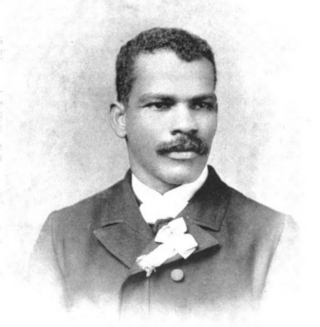
The Universal Negro Improvement Association and African Communities League (UNIA-ACL) is a black nationalist fraternal organization founded by Marcus Garvey, a Jamaican immigrant to the United States, and his then-wife Amy Ashwood Garvey. The Pan-African organization enjoyed its greatest strength in the 1920s, and was influential prior to Garvey's deportation to Jamaica in 1927. After that its prestige and influence declined, but it had a strong influence on African-American history and development. The UNIA was said to be "unquestionably, the most influential anticolonial organization in Jamaica prior to 1938," according to Honor Ford-Smith.
An African American is a citizen or resident of the United States who has origins in any of the black populations of Africa. African American-related topics include:

The African Methodist Episcopal Zion Church, or the AME Zion Church (AMEZ) is a historically African-American Christian denomination based in the United States. It was officially formed in 1821 in New York City, but operated for a number of years before then. The African Methodist Episcopal Zion Church adheres to Wesleyan-Arminian theology.

The black church is the faith and body of Christian denominations and congregations in the United States that predominantly minister to, and are also led by African Americans, as well as these churches' collective traditions and members. The term "black church" may also refer to individual congregations, including in traditionally white-led denominations.
Wallace Augustus Rayfield (1874–1941), was an American architect and educator. He was the second formally educated practicing African American architect in the United States.

Religion of black Americans refers to the religious and spiritual practices of African Americans. Historians generally agree that the religious life of black Americans "forms the foundation of their community life". Before 1775 there was scattered evidence of organized religion among black people in the Thirteen Colonies. The Methodist and Baptist churches became much more active in the 1780s. Their growth was quite rapid for the next 150 years, until their membership included the majority of black Americans.

Daniel Coker (1780–1846), born Isaac Wright, was an African American of mixed race from Baltimore, Maryland. Born a slave, after he gained his freedom, he became a Methodist minister in 1802. He wrote one of the few pamphlets published in the South that protested against slavery and supported abolition. In 1816, he helped found the African Methodist Episcopal Church, the first independent black denomination in the United States, at its first national convention in Philadelphia.

Sidney Rose Badgley was a prominent start-of-the-20th-century Canadian-born architect. He was active throughout the United States and Canada, with a significant body of work in Cleveland.

Springfield Baptist Church is a Baptist church in Augusta, Georgia was built in 1801 and is a significant historical building for its architecture, religious history, and African American heritage. It is affiliated with the American Baptist Churches USA.

Robert Josias "Raphael" Morgan was a Jamaican-American who is believed to be the first Black Eastern Orthodox priest in the United States. After being active in other denominations, including the AME Church, Church of England, and the Episcopal Church, Morgan converted to Orthodoxy. He was ordained as an Orthodox priest of the Ecumenical Patriarchate. He was designated as "Missionary to America and the West Indies." He claimed to have founded the "Order of Golgotha", but the Orthodox Church is not organized into orders.

St. Joseph's African Methodist Episcopal Church is a historic African Methodist Episcopal church building located at Fayetteville Street and Durham Expressway in the Hayti District, now a neighborhood of Durham, Durham County, North Carolina.

Ernest A. Lyon was an African-American minister, educator and diplomat.

Hayti, also called Hayti District, is the historic African-American community that is now part of the city of Durham, North Carolina. It was founded as an independent black community shortly after the American Civil War on the southern edge of Durham by freedmen coming to work in tobacco warehouses and related jobs in the city. By the early decades of the 20th century, African Americans owned and operated more than 200 businesses, which were located along Fayetteville, Pettigrew, and Pine Streets, the boundaries of Hayti.

Shiloh Baptist Church is a historic Baptist church in King-Lincoln Bronzeville, Columbus, Ohio. One of the oldest black churches in the city, it has been active since the 1860s, and its 1920s building has been named a historic site.

Emanuel African Methodist Episcopal Church, colloquially Mother Emanuel, is a church in Charleston, South Carolina, founded in 1817. It is the oldest AME church in the Southern United States; founded the previous year in Philadelphia, Pennsylvania, AME was the first independent black denomination in the nation. Mother Emanuel has one of the oldest black congregations south of Baltimore.

Grace Methodist Episcopal Church, also known as Mount Moriah Missionary Baptist Church, is a historic building located in Waterloo, Iowa, United States. The congregation that built this building was organized in 1861 as First Methodist Episcopal Church. They built church buildings in 1865 at Lafayette and East Fifth Streets, and then at East Fourth and Mulberry Streets in 1877. They changed their name to Grace in 1895. They completed this building at Walnut and East Fifth Streets in 1913. The brick, Neoclassical structure designed by Turnbill & Jones features a large central dome and a large classical portico with six Ionic columns. Mount Moriah Missionary Baptist Church acquired the building from Grace United Methodist in 1996. The building was listed on the National Register of Historic Places in 2011.

The A.M.E. Zion Church of Kingston is an African Methodist Episcopal Zion Church located in Kingston, New York. Founded in 1848, as a land grant from wealthy Black residents, Mrs. Sarah-Ann Hasbrouck and her husband, Alexander, it is the oldest continuous African-American congregation in Kingston and Ulster County. The church is located at 26 Franklin Street in the city's Fourth Ward.
















